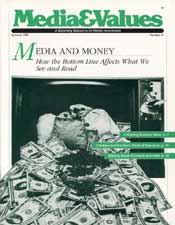Get Down to Business News
|
This article originally appeared in Issue# 47
|
How to Evaluate Coverage that Affects Your Pocketbook
Three things sell newspapers and boost ratings: sex, suffering and silver (money). This at least is the typical formula many news organizations use in planning their offerings. While the decisions of editorial departments should in no way be influenced by what is happening on the advertising and the commercial sides of the news business, this gap has shrunk or evaporated in many news organizations, both print and electronic.
With the decline of family publishing empires, increased mechanization in production techniques and the rising concentration and internationalization of the news business, the autonomy of many editors and publishers has withered. The motto of much of the popular press today is not "all the news that's fit to print" but "all the news that's fit to sell."
Economic pressures on the editorial desk have many consequences. There is less money for a large reporting staff. There is less or no money for foreign correspondents. Reporters and writers have to produce more copy. They have less time for investigative and analytical pieces. There is less time to do stories that are "in the public interest" or that tackle unpopular or unpleasant subjects. More material must be geared to attract the target audience that advertisers want to reach.
Economics reporting, in particular, suffers. In fact, many papers, magazines, radio and TV stations have collapsed most of their coverage into business sections geared for corporate executives and private investors. Only the large city dailies can afford to keep a labor reporter, for example. Few have the capacity to analyze local or regional economic trends, or to bring the impact of national and international conditions home.
What can you do to alter this situation? Plenty.
- Be an active consumer of news. Help shape your local media coverage by writing letters to editors and news directors, meeting with editors, producers or writers to discuss your concerns and offering story and source suggestions. Radio and TV stations must renew their licenses periodically - a process that allows for public input. Speak up, offer your opinions and work for improvements. Talk to your legislators about better funding for public broadcasting, more audience-oriented regulation of broadcasting and tougher scrutiny of media mergers and acquisitions.
- Broaden your economic news sources. The following is a sample of a wide variety of business and economics publications. How many of them are you familiar with? How do they differ? Which ones interest you the most?
- Business Week (http://www.businessweek.com)
- Barrons (http://www.barrons.com)
- Left Business Observer (http://www.leftbusinessobserver.com)
- Dollars and Sense (http://www.dollarsandsense.com)
- The Nation (http://www.thenation.com)
- Fortune (http://www.fortune.com)
- Inc. (http://www.inc.com/home/)
- The Economist (http://www.theeconomist.com)
- Support alternative perspectives. A community group might meet with your local newspaper editor or television news director to suggest they subscribe to Inter-Press Service (IPS) (http://www.ipsnews.net) A cooperatively-run news service with a much more internationalist approach, IPS is the third largest wire service in the world. It has a greater sensitivity to Third World issues and perspectives than AP, UPI, Reuters, Agence France-Press and other Western news services.
BETWEEN THE LINES
Use the following questions in a group discussion or in your own reading and viewing to evaluate media coverage of economics and business news.
1. How complete is the story? Are underlying causes and the human consequences of the economic events or developments discussed? Are connections between local, national and international events made clear? Is follow-up and background provided? What questions would you ask if you were the reporter?
2. Who are the sources? Is the story told from the official point of view only? How would it differ if a person of another gender, color, class or nationality were interviewed? How many alternate viewpoints are presented?
3. Who is the audience? Assumptions about viewers, listeners or readers shape perspective. How would the information presented change if different groups were addressed?
4. Who's selling what? Does the presence of major advertisers in ads or commercials seem to affect what's being reported? How do ads or commercials related to the prospective audience?
For Newspaper Readers
5. What kind of business/economic stories make the front page? What kind of stories are reported in the business section?
6. How much of national/international stories are written by local reporters? By wire services? Do additional stories cover such local angles as effects on community employment and working conditions at major local employers?
7. What advertisers advertise in the business section? Throughout the newspaper? Do you think the presence of these ads influence the amount or kind of stories on the same page or in other sections?
8. Take a typical page of your favorite newspaper and with a ruler, measure the number of column inches for advertising and for news stories. Are you surprised?
For Television Watchers
9. Use a watch with a second hand to measure the time allotted to business or economic reports during local or national news. What portion of the overall newscast does this represent?
10. What kind of visuals are used - people at work? Charts and graphs? Scenes of Wall Street activities? What emotional impact do they convey?
11. Do the stories simply report economic indicators (e.g. the latest unemployment statistics or rise in interest rates)? Or do they discuss economic events in terms of their larger social impact, problem or trend?



